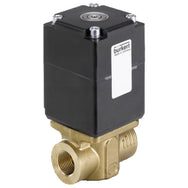Collection:Proportional Solenoid Valves
A proportional solenoid valve controls the flow rate or pressure of a fluid or gas passing through it in proportion to an electrical input signal from a controller. Unlike traditional solenoid v... Read more
Proportional Solenoid Valves

A proportional solenoid valve controls the flow rate or pressure of a fluid or gas passing through it in proportion to an electrical input signal from a controller. Unlike traditional solenoid valves, which only open or close completely, proportional solenoid valves allow for fine-tuning, providing variable control and enabling the valve to be partially open to any degree within its range.
Proportional solenoid valve advantages
- Fast response time, typically less than 15ms
- Compact design
- Designed for proportional control with excellent adjustment characteristic
- Good protection against the environment thanks to the IP65 rating
Main applications
- Injection molding: They regulate the flow of molten plastic with high precision in injection molding machines, which is vital for producing consistent, high-quality plastic parts with the correct dimensions and material properties.
- Hydraulic systems: In hydraulic machinery, such as excavators or presses, proportional solenoid valves control the flow and pressure of hydraulic fluid, allowing for smooth and precise operation of actuators and other hydraulic components.
- Fuel metering and control: These valves are used in fuel delivery systems for combustion engines, including those in power generation, to ensure optimal air-fuel mixtures for efficient combustion and reduced emissions.
- Medical devices: Proportional solenoid valves are employed in life-supporting medical devices, such as ventilators, where they precisely control the flow of air or oxygen to patients, as well as in other medical equipment like dialysis machines for accurate fluid regulation.
- Climate control systems: In HVAC systems, these valves manage the flow of refrigerant or hot water to maintain precise temperature and humidity levels in commercial buildings, data centers, and industrial facilities, ensuring comfort and protecting sensitive equipment.
Selection criteria
- Material: Ensure that the proportional valve housing (like aluminum, brass, or stainless steel) and seal (FKM, EPDM, PTFE, etc) match the medium used.
- Flow characteristics: The valve must handle the required flow rates. This includes understanding the valve's flow coefficient (Cv), which indicates how much fluid can pass through the valve, and ensuring it matches the system's flow requirements.
- Operating pressure: The valve should be rated for the operating pressure range of the system. Considering the minimum and maximum pressures the valve will encounter is important.
- Bore size: Ensure the orifice diameter matches the flow requirements of your system, allowing for the desired flow rate without causing excessive pressure drop or flow velocity.
- Connection type: The valve ports can be either flanged or threaded. Also, a DIN connector may be required to connect the valve to the power supply.
- Fluid compatibility: The materials of the valve's components must be compatible with the fluid it will control, whether air, water, oil, or aggressive chemicals. This includes the body material, seals, and other parts that come into contact with the fluid.
- Voltage and power requirements: The electrical characteristics of the solenoid, such as voltage and power consumption, should be compatible with the available power supply and control signals.
- Response time: The valve's response time should be suitable for the dynamics of the application. Faster response times are necessary for applications requiring quick flow or pressure adjustments.
- Temperature range: The valve must be able to operate within the temperature range of the application, both ambient and fluid temperature.
- Size and port connections: The physical size of the valve and the type of port connections must fit within the system's space constraints and be compatible with the existing piping or tubing.
- Control signal: The valve should be compatible with the type of control signal used in the system, like 0-10V, 4-20mA, or PWM).
- Resolution and hysteresis: The valve should have a high resolution to allow for fine control and low hysteresis to minimize variations in flow when the control signal changes.
- Duty cycle: The valve should be rated for the expected duty cycle in the application, which includes the frequency of operation and the duration of each cycle.
- Custom design options: Specialized valve designs like energy efficient, fat and oil-free, suitable for oxygen and vacuum, etc, are available. Also, certain models of proportional valves are suitable for demanding conditions, like dry gasses and high control voltage.
When to choose a proportional solenoid valve
Opt for a proportional solenoid valve when your system demands fine-tuned flow or pressure adjustments, not just fully open or shut states. This is essential in dynamic environments where the valve must respond to varying conditions, such as closed-loop systems that automatically adjust based on sensor feedback.



